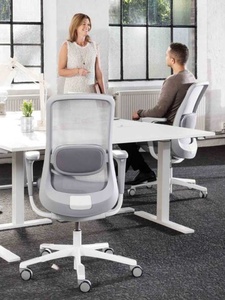In the hustle and bustle of our daily work lives, whether its working from home or from the office, it's easy to forget about our physical well-being. Whether your struggling to find working from home exercises or simple office stretches, we've got you covered!
Long hours at the desk can take a toll on our bodies, leading to stiffness and discomfort.
But fear not! A 10-minute stretching routine right at your workstation can make a world of difference. Imagine a brief pause in your day, a chance to refresh and rejuvenate!
Let's explore some simple, yet highly effective stretches for your neck, shoulders, back, and hips that you can seamlessly incorporate into your work routine and can be done from your desk.
Pain From Working At A Computer - The Facts!
It's easy to write off pain from working at a computer as just a simple thing that will go away eventually. However, a small pain today can lead to a big issue down the road, which can be seriously debilitating!
Since COVID, more and more Irish workers are working from home, either full-time, or hybrid. This sudden shift in working habits has drastically changed the landscape of office work in Ireland.
80%
Of office workers will experience MSD at some point.
48%
Of remote workers during Covid, didn't have a dedicated workstation.
62%
Neck Pain is the most common issue among Office Workers
Office Stretches - The 10-Min Workstation Workout!
There are many causes of pain from working at a computer all day. However, one thing that's clear, is that we aren't moving enough throughout the day.
So let's get into how to fix that!
1. Neck Pain From Working At A Computer
As the neck is the most commonly affected area, we'll begin there!
Begin with gentle neck stretches to release tension accumulated from hours of staring at screens.
The most common postural issue with the neck is that it is leaning forward known as Tech Neck.
This occurs when the screens are too low or high to where the muscles must work to hold the head.
The levator scapulae and upper trapezius muscles are often strained during prolonged forward head posture and can lead to pain or even headaches.
The solution is to keep your chin in a neutral position while you work and stretch the neck throughout the day promoting flexibility and reducing tension.
Neck Stretches For Office Work
- Slowly tilt your head to one side, feeling a stretch along the opposite shoulder.
- Hold for 15 seconds and switch sides, do this 2 times each side.
- Follow this with a forward and backward tilt and conclude with a gentle neck rotation.
- These simple motions can enhance flexibility and reduce stiffness.
Chin Tucks
- Sit or stand up straight, and gently tuck your chin towards your chest, feeling a stretch along the back of your neck.
- Hold for 15-20 seconds.
2. Shoulder Pain From Office Work
Shoulder tension is a common woe for desk-bound individuals.
This can be due to the overuse of the muscles while working when not using correct ergonomic posture. One of the main ways to prevent shoulder discomfort is to set the armrests of your Ergonomic Chair up correctly. Ideally your ergonomic chair will have height adjustable armrests. If your office chair doesn't have adjustable armrests, it may not be actually ergonomic! Here's what to look for in an Ergonomic Chair!
The key is to set them to a height to where your shoulders feel supported but also relaxed and not pushed up too high or low which creates tension on the muscles.
Then slide the chair in towards the edge of the desk and see if the armrests are perfectly level. If they are either too high or low just change the chair height until they are flush.
Then pull your keyboard and mouse towards the edge and slide all the way in until the armrest touches the desk. This allows you to then sit back and relax your arms on the armrest while being able to use the keyboard without ever having to lift or reach forward.
Shoulder Rolls
- Sit up straight, roll your shoulders backward in a circular motion for 30 seconds, and then switch to a forward roll 2/3 times a day.
- This exercise helps improve circulation and alleviate tightness in the shoulder and upper back region.
Eagle Arms
- Bring your arms in front of you, crossing your right arm over the left.
- Bend your elbows, bringing your palms together.
- Lift your elbows to shoulder height and hold for 20 seconds.
3. Back Pain From Working At A Computer
The back often gets the brunt of the force while sitting and this could lead to discomfort over time.
The best ways to minimize back pain is to move every 30 minutes for a micro break (2min) or, at minimum, every hour to get off the chair (2min).
The reason behind this is that the load builds up in the lower back while sitting.
Also, by keeping your shoulder blades/ upper back always engaged with the backrest it takes pressure from being sent into the lower lumbar.
The erector spinae muscles along the spine and the muscles in the lower back can experience strain from prolonged sitting and poor posture.
Seated back extensions and twists engage the erector spinae muscles, promoting flexibility and strength.
These stretches also activate the core muscles, contributing to better support for the spine and reducing the risk of lower back pain.
Back Stretch
- Sit upright, interlink your fingers, and extend your arms in front of you.
- Inhale deeply and arch your back, opening your chest toward the ceiling.
- Hold for 20 seconds, exhale, and return to an upright position.
- This stretch promotes flexibility in the spine and relieves tension in the lower back.
Seated Twist
- Sit up straight, twist your torso to the right, placing your left hand on the outside of your right knee and your right hand on the back of the chair.
- Hold for 20 seconds, then switch sides.
4. Hip Pain From Sitting
Sedentary jobs often contribute to tight hips due to shortening your hip angle while working seated at the desk.
So please remember to always have your seat height raised up to where your hips are above your knees. A good way to visually check if the position is correct is take a pen/ pencil place on the top of your lap and give it a push. If it rolls down off the knee you are in a good position for the hips however, if it doesn’t roll just raise the chair height slightly until it does.
Prolonged sitting tightens the hip flexor muscles, specifically the iliopsoas. Between correct chair height and moving regularly means that the hip muscles don’t remain in a shortened position for too long which is when the tightness will then occur.
Hip stretches like the pigeon pose and seated leg cross target the hip flexors, reducing tightness and improving flexibility.
Stretching these muscles contributes to better hip joint health and helps prevent discomfort associated with prolonged sitting.
Hip Stretches For The Office
Pigeon Pose
- While seated, cross your right ankle over your left knee.
- Gently press down on your right knee to feel a stretch in your right hip.
- Hold for 20 seconds, then switch sides.
Hip opener stretch
- While seated, scoot to the middle of your chair but be careful the chair doesn’t roll back.
- Cross one ankle over the opposite knee. Keep your back straight and hinge forward at the hips, feeling a stretch in your right hip.
- Hold for 20 seconds and switch sides.
Summary
In just 10 minutes, this simple stretching routine can transform your workday, leaving you more energized and focused.
The key is consistency – make these stretches a daily habit to experience lasting benefits.
Remember, a healthy body contributes to a healthy mind. So, take that short break, show your body some love, and enhance your overall well-being.
Your desk may be where you work, but with a little stretching, it can also be where you revitalize. Incorporate these stretches into your daily routine and let the positive effects ripple through your work and beyond.
Your body will thank you!

Kevin Dawson
Ergonomics Consultant
Kevin Dawson, an experienced ergonomic consultant with expertise in biomechanics, physiology, and injury management, honed through a Bachelor's degree in Sport Science, is dedicated to helping individuals achieve optimal well-being and productivity.
With extensive hands-on experience analyzing work environments and designing solutions that enhance comfort and align seamlessly with individual needs, he empowers individuals to move freely, reducing discomfort and maximizing performance.
Ergonomic Products To Help Your Pain















